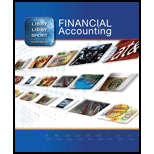
Financial Accounting, 8th Edition
8th Edition
ISBN: 9780078025556
Author: Robert Libby, Patricia Libby, Daniel Short
Publisher: McGraw-Hill Education
expand_more
expand_more
format_list_bulleted
Concept explainers
Textbook Question
Chapter E, Problem 2Q
Explain the difference in accounting methods used for passive investments, investments in which the investor can exert significant influence, and investments in which the investor has control over another entity.
Expert Solution & Answer
Want to see the full answer?
Check out a sample textbook solution
Students have asked these similar questions
General accounting
None
Provide correct answer the general accounting question
Chapter E Solutions
Financial Accounting, 8th Edition
Ch. E - Prob. 1QCh. E - Explain the difference in accounting methods used...Ch. E - Explain how bonds held to maturity are reported on...Ch. E - Explain the application of the cost principle to...Ch. E - Under the fair value method, when and how does the...Ch. E - Under the equity method, why does the investor...Ch. E - Prob. 7QCh. E - Prob. 8QCh. E - Prob. 9QCh. E - Company X owns 40 percent of Company Y and...
Ch. E - Prob. 2MCQCh. E - Dividends received from stock that is reported as...Ch. E - Prob. 4MCQCh. E - Prob. 5MCQCh. E - When using the equity method of accounting, when...Ch. E - Prob. 7MCQCh. E - Prob. 8MCQCh. E - Which of the following is true regarding the...Ch. E - Prob. 10MCQCh. E - Matching Measurement and Reporting Methods Match...Ch. E - Prob. 2MECh. E - Prob. 3MECh. E - Prob. 4MECh. E - Prob. 5MECh. E - Prob. 6MECh. E - Prob. 7MECh. E - Prob. 8MECh. E - Prob. 9MECh. E - Prob. 10MECh. E - Prob. 11MECh. E - Prob. 1ECh. E - Prob. 2ECh. E - Prob. 3ECh. E - Prob. 4ECh. E - Prob. 5ECh. E - Prob. 6ECh. E - Prob. 7ECh. E - Prob. 8ECh. E - Prob. 9ECh. E - Prob. 10ECh. E - Prob. 11ECh. E - Prob. 1PCh. E - Prob. 2PCh. E - Prob. 3PCh. E - Prob. 4PCh. E - Prob. 5PCh. E - Prob. 6PCh. E - Prob. 7PCh. E - Recording Investments for Significant Influence LO...Ch. E - Prob. 9PCh. E - Prob. 10PCh. E - Prob. 11PCh. E - Prob. 1APCh. E - Prob. 2APCh. E - Prob. 3APCh. E - Prob. 4APCh. E - Prob. 5APCh. E - Prob. 6APCh. E - Prob. 1CPCh. E - Prob. 2CPCh. E - Prob. 3CPCh. E - Prob. 4CPCh. E - Prob. 5CPCh. E - Prob. 6CPCh. E - Prob. 1CC
Knowledge Booster
Learn more about
Need a deep-dive on the concept behind this application? Look no further. Learn more about this topic, accounting and related others by exploring similar questions and additional content below.Similar questions
arrow_back_ios
SEE MORE QUESTIONS
arrow_forward_ios
Recommended textbooks for you
 Cornerstones of Financial AccountingAccountingISBN:9781337690881Author:Jay Rich, Jeff JonesPublisher:Cengage Learning
Cornerstones of Financial AccountingAccountingISBN:9781337690881Author:Jay Rich, Jeff JonesPublisher:Cengage Learning Intermediate Accounting: Reporting And AnalysisAccountingISBN:9781337788281Author:James M. Wahlen, Jefferson P. Jones, Donald PagachPublisher:Cengage LearningPrinciples of Accounting Volume 2AccountingISBN:9781947172609Author:OpenStaxPublisher:OpenStax College
Intermediate Accounting: Reporting And AnalysisAccountingISBN:9781337788281Author:James M. Wahlen, Jefferson P. Jones, Donald PagachPublisher:Cengage LearningPrinciples of Accounting Volume 2AccountingISBN:9781947172609Author:OpenStaxPublisher:OpenStax College EBK CONTEMPORARY FINANCIAL MANAGEMENTFinanceISBN:9781337514835Author:MOYERPublisher:CENGAGE LEARNING - CONSIGNMENT
EBK CONTEMPORARY FINANCIAL MANAGEMENTFinanceISBN:9781337514835Author:MOYERPublisher:CENGAGE LEARNING - CONSIGNMENT

Cornerstones of Financial Accounting
Accounting
ISBN:9781337690881
Author:Jay Rich, Jeff Jones
Publisher:Cengage Learning

Intermediate Accounting: Reporting And Analysis
Accounting
ISBN:9781337788281
Author:James M. Wahlen, Jefferson P. Jones, Donald Pagach
Publisher:Cengage Learning

Principles of Accounting Volume 2
Accounting
ISBN:9781947172609
Author:OpenStax
Publisher:OpenStax College


EBK CONTEMPORARY FINANCIAL MANAGEMENT
Finance
ISBN:9781337514835
Author:MOYER
Publisher:CENGAGE LEARNING - CONSIGNMENT

ACCOUNTING BASICS: Debits and Credits Explained; Author: Accounting Stuff;https://www.youtube.com/watch?v=VhwZ9t2b3Zk;License: Standard Youtube License